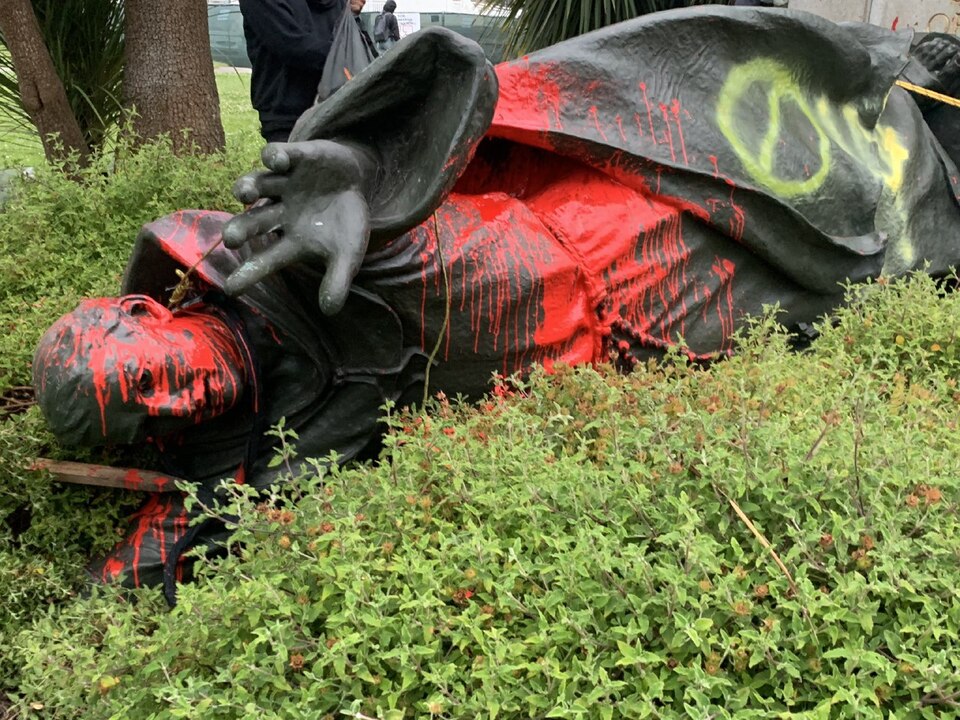This Monday, in the “Theology for Millennials” section, Father Mario Arroyo analyzes the recent toppling of statues of Saint Junipero Serra in San Francisco and Los Angeles, as part of the racial protests in States for the death of Afro-American George Floyd.
The Mexican priest clarifies that summary judgments on history can’t be done without committing profound injustices. Saint Junipero is a palpable example of this.” So he reminds that Saint Junipero was a man who left his land to dedicate his life to evangelize; who left his monastery in Queretaro, walking 3327 kilometers to San Francisco, who gave life to the Franciscan missions in California, which were the cradle of the great Californian cities of the present.
Saint Junipero “strongly defended the native peoples,” says Father Mario Arroyo. “He did not spare himself a trip to Mexico City, the seat of the Viceroyalty, to present a “Declaration of Rights” that defended the Indians and called for their protection.” Continue reading and discover the exciting life of this Saint.
Father Mario Arroyo has a Licentiate in Philosophy from the Pan-American University, Mexico D.F. In addition, he has a Doctorate in Philosophy from the Pontifical University of the Holy Cross in Rome. He lives in Mexico at present and is a Professor of Theology at the Pan-American University.
* * *
Junipero, Activism, and Ignorance
The historical slander that the distinguished figure of Saint Junipero Serra is suffering at present is truly painful. A grave offense to the truth that, as usually happens with lies, is used to manipulate public opinion, making use of useful idiots that make a huge “straw man,” fallacious deceit. A “slander that continues somewhat,” and it continues more if the recipients of the deceit are ignorant. In our days we see the disastrous consequences of the marriage between political activism and superficial ignorance, to the point of seeing institutions threatened, which are the basis of a civilized society, while history is re-written artfully for the benefit of the ideology in fashion.
It is painful that the iconoclastic fury unleashed against Saint Junipero arises in the midst of a very developed society, with high standards of education. It’s sad to see how the lack of seriousness and the absence of profundity, namely, the most painful superficiality, have taken over the place that is in the vanguard of technology in the world. It cannot but be an extremely bad omen to discover how, where the greatest technological advancements take place, in the cradle of power of our civilization, barbarism arises with impunity, and ignorance is worshipped.
To do away with the statues of Saint Junipero in Los Angeles and San Francisco, to establish an inquisitorial process against him, full of anachronistic arguments, selective ignorance, and falsehoods, to legitimize the use of violence, instead of serious discussion and profound study, cannot but be signs of manipulation, a manifestation of the decline of a civilization. As before in Rome, the barbarians again take over the lordship of the world’s most powerful country.
Summary judgments on history cannot be done without committing profound injustices. Saint Junipero is a palpable example of this. A man who left his land to dedicate his life to evangelize, who left his monastery in Queretaro, walking 3327 kilometers to San Francisco, who gave life to the Franciscan missions in California, which were the cradle of the great Californian cities of the present. A man who learned the language of the Californian natives, who lived with them and loved them, now is the paladin of racism, if not genocide.
Saint Junipero strongly defended the native peoples. He did not spare himself a trip to Mexico City, the seat of the Viceroyalty, to present a “Declaration of Rights” that defended the natives and called for their protection. To be highlighted in his epistolary are his frequent denunciations of sexual abuses committed against the natives by the conquistadores. He was opposed to the death penalty against those that destroyed the San Diego mission, killing a priest friend of his, to thus show a sign of Christian clemency, establishing a noble testimony against the death penalty in the North American territory. From his letters, we know of his very positive appreciation and impression of the natives, and he was one of the first Europeans to record and praise the natural beauties of California.
As opposed to what might be thought, the missions did not impose the faith by force. On the contrary, they were multi-cultural communities where natives and Spaniards worked together and mixed, giving origin to a mestizo population, a new people, with their own culture, of which there are still architectural, musical, literary and religious vestiges. The natives were not obliged to convert; only 10 or 20% of them embraced the Christina faith.
The “Californian genocide” happened a century after Saint Junipero, coinciding with the “gold fever” in California. It was the first Governor of that State who imposed the war of extermination against the Indians in 1851. In fact, Americans themselves have left abundant proof of it in the immense majority of Western films, where the evil and cruel Indians are always massacred. It was the cavalry of the North American army that was mainly in charge of perpetrating the genocide, not the Spanish missionaries. Therefore, one cannot but deplore the historical injustice committed against one of the forgers of California, Saint Junipero Serra.
Mario Arroyo
Doctor in Philosophy
p.marioa@gmail.com



